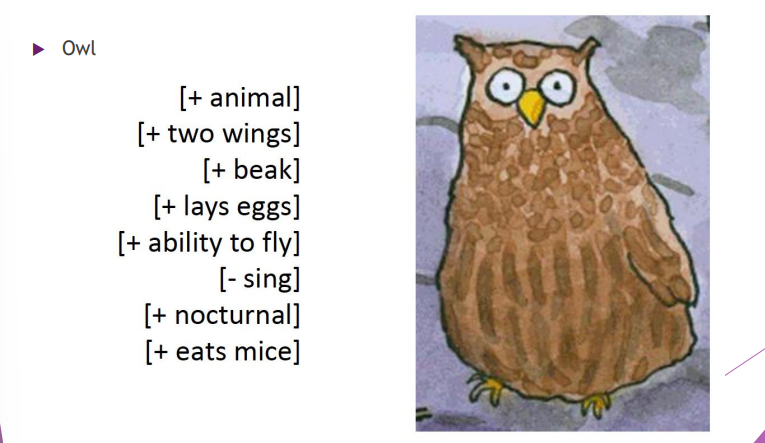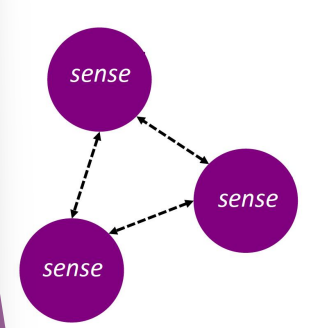Semantics Review
1/41
Earn XP
Description and Tags
Vocabulary flashcards based on lecture notes about semantics.
Name | Mastery | Learn | Test | Matching | Spaced |
|---|
No study sessions yet.
42 Terms
Sense
All elements contained in our conventional understanding of a concept associated with a word.
dog is “a domesticated carnivorous mammal, which typically has a long snout, an acute sense of smell, non-retractile claws, and a barking, howling, or whining voice” Oxford English Dictionary Online, s
Implies a level between words and the world
Level of mental representation
Mental concept - Sense relation + 2 concepts
mental representation between words and the world.
Simple concepts
Complex concepts
Simple Concepts (Mental Concepts)
Concepts related to perceptual stimuli.
e.g. sun, water, ...
Complex Concepts (Mental Concepts)
related to theories or cultural phenomina.
e.g. marriage, retirement, ...
Componential/Feature Analysis
breaks word meanings into binary features (e.g., [+ANIMATE]) to distinguish and compare lexemes within a semantic domain.
![<p>breaks word meanings into binary features (e.g., [+ANIMATE]) to distinguish and compare lexemes within a semantic domain.</p>](https://knowt-user-attachments.s3.amazonaws.com/f763d7f2-5ab2-48ad-97a2-4d21a3460ce7.png)
Semantic Components(Componential/Feature Analysis)
used to analyze word meanings.
Distinctive Features (Componential/Feature Analysis)
distinguish word meanings.
Binary Features (Componential/Feature Analysis)
Features presented using + or - signs.
e.g. [ + ANIMAL]
Types of components (Componential/Feature Analysis)
Common component
Diagnostic component
Common Component (Types of components (Componential/Feature Analysis))
typically listed as a first component shared by a set of lexemes,
e.g. [human] for man, boy, woman, girl, etc.
Diagnostic Component (Types of components (Componential/Feature Analysis))
typically listed after a first common component in order to distinguish a set of lexemes, e.g. [+/-male] for man, boy, woman, girl
formal,features of the form
functional,sth.’s purpose
Requirements for components(Componential/Feature Analysis)
3
primitive
general
linguistically motivated
Challenges to Features Semantics
If the necessary and sufficient features are present, something can be classified as X.
If those features are missing, it cannot be classified as X.
Conclusion:
If a shape has 3 sides and is closed → ✅ it's a triangle.
If it doesn't have 3 sides → ❌ it's not a triangle.

Structural Semantics
concepts based on relationships of words within a language system

paradigmatic
the relationship between words or concepts that can substitute for each other in a given context.
Example:
"The cat sat on the mat."
You could replace "cat" with:
dog
rabbit
child
Word meanings are defined in part by
what they have in common with other expressions, what distinguishes it from them→ signé différentiel (Saussure)
Cognitive Semantics
language as deeply connected to human thinking, and meaning as shaped by how we understand the world through experience.
Origins of Prototype Theory
Developed by psychologist Eleanor Rosch and colleagues at the University of California at Berkeley from the early 1970s onwards
Prototype Theory
we understand categories through typical examples, not fixed rules.
Meaning are flexible, experience-based, and graded, just like real life.
some members are more central than others, and boundaries can be fuzzy.
Prototype Theory
Some linguistic evidence A: Which toad do you like best? B: The yellow one? A: The one on the far right? B: The yellow yellow one. Look at that cat-ish creature over there. I‘m kinda tired. Can you think of any other linguistic expressions or constructions that suggest that word meaning is organized prototypically?
Categories without Prototypical Organization
concepts …
concepts with multiple meanings, e.g. over
concepts with missing prototypes, compare: e.g. cities
concepts with too heterogeneous extensions, e.g. new species
concepts with too complex and intricate meanings, e.g. belief
Traditional Accounts of Metaphor
special feature of language, separate from everyday meaning, needing extra effort to interpret.
Conceptual Metaphors - Lakoff
The metaphor "ARGUMENT IS WAR" shows how we use language from war to talk about arguments. This isn’t just language — it reflects how we think about arguments.
Conceptual Metaphors
fundamental to our understanding of the world and influence both language and thought deeply.
aren’t just decorative
Mapping Metaphors
how we understand abstract concepts by linking them to more concrete ideas, and we see this in the way we talk every day through metaphorical expressions.
source domain
starting point of the mapping process
concrete concept/domain
target domain
goal of the mapping process
abstract concept/domain
Features of Conceptual Metaphors
Systematicity
Asymmetry/Directionality
Abstraction
Systematicity (Features of Conceptual Metaphors)
features of the source and target domain are joined so that the metaphor can be extended,
cf. LIFE IS A JOURNEY: person –traveller, purposes –destinations, means for achieving purposes –routes, …
Asymmetry/Directionality(Features of Conceptual Metaphors)
transfer from the source to the target domain,
i.e. mappings do not work into the opposite direction, *A JOURNEY IS LIFE
Abstraction (Features of Conceptual Metaphors)
use of a more concrete source domain to describe a more concrete target domain, source is often linked to concrete physical/bodily experiences,
e.g. movement through space
Metonymy overlap with metaphor
Referential strategy in language use→ conceptual processes
Conventionalized to a large extent
Used to create new lexical resources in language
Depends on real-world knowledge
Metonymy differences from metaphor
metaphor= mapping across two conceptual domains
metonymy= establishes a connection within a single conceptual domain → based on conceptual contiguity
Type of Metonymical Relations 9
PART FOR WHOLE
WHOLE FOR PART
CONTAINER FOR CONTENT
CONTENT FOR CONTAINER
MATERIAL FOR OBJECT
PRODUCER FOR PRODUCT
PLACE FOR INSTITUTION
PLACE FOR EVENT
CAUSE FOR EFFECT
PART FOR WHOLE; WHOLE FOR PART (Type of Metonymical Relations)
all hands on deck; Brazil won the world cup
CONTAINER FOR CONTENT; CONTENT FOR CONTAINER(Type of Metonymical Relations)
I don't drink more than two bottles; Could I have a beer, please?
MATERIAL FOR OBJECT (Type of Metonymical Relations)
She needs a glass
PRODUCER FOR PRODUCT (Type of Metonymical Relations)
I'll buy you that Rembrandt; I've drawn your silhouette
PLACE FOR INSTITUTION (Type of Metonymical Relations)
Downing Street has made no comment; The White House has announced ...;
PLACE FOR EVENT (Type of Metonymical Relations)
Hiroshima changed our view of war
CAUSE FOR EFFECT (Type of Metonymical Relations)
His native tongue is Hausa
Influence on Language Change(metonymy and metaphor)
language change by extending meanings into new areas.
These shifts result in words gaining multiple, related senses — making the language more expressive and flexible.